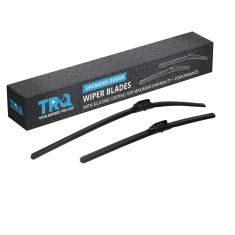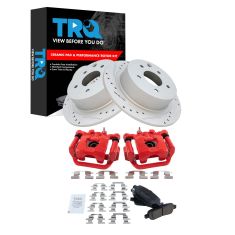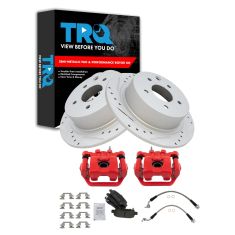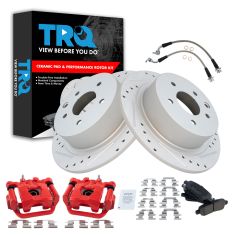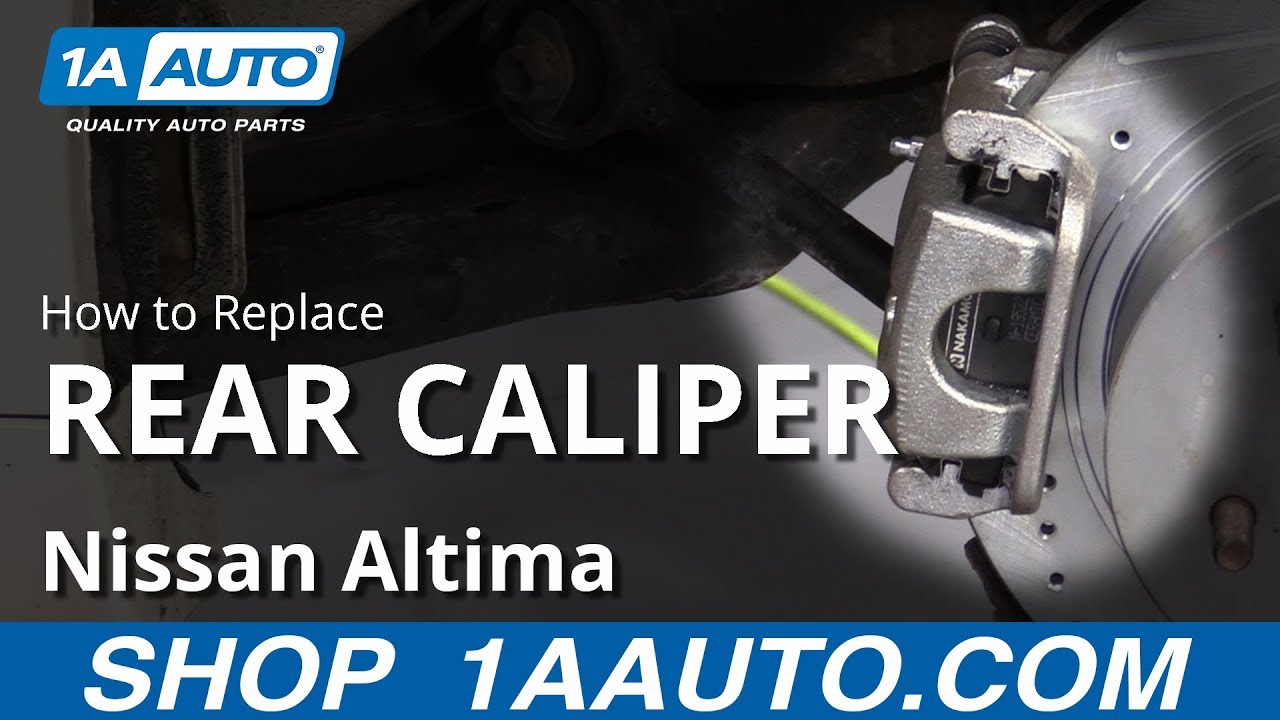Hey, everyone. It's Len from 1A Auto. Today I'm going to be showing you how to replace calipers on a 2010 Nissan Altima. It's going to be a very simple job, and I'm going to be the guy that shows you how to do it. If you need these, or any other quality part, it's always a safe bet to check in to 1AAuto.com and we'll be sure to take care of you the best we can.
Now we have our vehicle partially supported off the ground. We want to make sure the wheel's still touching. We're just going to break all five of these lug nuts free, and we don't need to loosen them up very much. We just want to break them free, so when we get it up off the ground, we don't have to worry about spinning the wheel trying to break them free. One, and we're going to be using our 21 millimeter socket. We're on our last two. That one off. All right.
I like to leave one on there when I'm removing the last one, so I'll just put that second to last one back on a couple threads. Now we'll go ahead and remove this last one. The reason for that is so the wheel can't come loose, fall and hurt anybody. Safety is key here at 1A Auto. Last one. Now we'll just go ahead and remove this second to last one that we started on. Holding the wheel. Take off that hub cap. Here we go. Being careful not to drop it too hard.
One of the first things we're going to want to do is make sure we're wearing safety glasses and hand protection. Also you want to make sure you have a receptacle to catch any brake fluid that might fall. You're going to remove this bleeder boot. We're going to try to break this bleeder screw free. Broke free nice and easy. I can see fluid coming out. You always want to make sure fluid comes out. If fluid doesn't come out, there might be an issue with the bleeder screw, in which case when you try to push back the caliper piston, it's going to cause an issue, forcing it back up through your brake lines, and it will be a big issue for your ABS unit.
So for now I'm just going to snug that up again. For me, I like to use something like this. It just goes down into a sealed receptacle. I can go like that. I'm going to open up this bleeder screw once again. Now I can use a small pry bar, or you can use a screwdriver or whatever you might have. You can go between the caliper and the pad and try to force the caliper this way, and basically what that's going to do is it's going to push the piston in. Now we'll be able to diagnose if the piston's any good. Nice and easy. It's not a race. Now push back nice and easy.
We can see the caliper can move freely, so we know the sliders are good. The piston's in as far as it can go. Now we can close up this bleeder screw. We're clear to remove these two screws, or bolts, which is the caliper to the caliper bracket.
All right, we've got our 14 millimeter wrench. We're going to try to break this free. Then we'll come up here to the top. Something we might notice is that when this comes free, the caliper slider's going to want to slide out. We've got an arm in the way. So what we are going to do is we're just break it free. The other one free. Then we're going to come down and we're just going to remove the whole bracket, and then we'll be able to get this right out of the way, and we can finish removing this from the caliper bracket. It's a lot easier to break it free while it's still mounted to the vehicle. There we are. Now we can go ahead and remove these caliper bracket bolts using a 19 millimeter socket and a ratchet, or a wrench if that's what you prefer to use.
The first one is broken free. Leave it in there though. Move on down to the next one. See if we can get to it. As you can tell, there really isn't much room. What we might have to use here is a shallow socket with a swivel head extension, or even just a swivel socket. So I decided to go with a 19 millimeter wrench, because it's something that more than likely everybody has, and a rubber mallet. I'm going to very carefully break this free. A couple more whacks. It feels good. Now that I know I have both these freed up, I can go ahead and use a ratchet wrench. Both these pretty loose. Leave that one in there. Come down here and finish taking this one out. Almost there. There's one. Has a washer. Second one's about to come out. There's two. It also has a washer. You want to make sure you keep those washers. If you happen to lose one, you need to make sure that you get another one.
If you don't have a washer in there, the bolt's going to come through further than it should, and it'll probably hit up against the inside of your rotor, and that'll cause an issue. Now we can go ahead and remove the caliper. You never want to let the weight of the caliper hang on the hose. It could cause a tug. You don't want a tug. So if you have something you can hold it up with, that works, or if you just want to rest it on something that's already in the vehicle, that works as well. So to continue removing this caliper, we're going to pinch off this brake line so brake fluid can't continue to drip out. Pinch this. Make sure our ratchet's in reverse just to the left. Break that free. I'm going to hold it. Make sure I'm wearing my safety glasses and my gloves. There we are. Move that down over here. Now we've got our caliper out. So out with the old and in with the new.
Here we have a quality 1A Auto part. Comes with everything you need for the install. An installation video by me. We got the little copper crush gaskets here. These are very important to replace. You never want to use the old ones that came out with your old caliper, because they've already been crushed and fitted into the old hole. As you can tell, everything's the exact same on this with the screw placement. It's the same. Got your sliders and brand new boots. So very high quality part right here. Comes with new tins. Which is very important. To me personally, I wouldn't see any reason why this wouldn't be a great part to replace this original quality part with. So for this, or any other quality part, you can always come down to 1AAuto.com and we'll be sure to help you out.
So now, even though we have our new caliper, we're still going to disassemble it all and make sure everything's clean and lubed. Sometimes from the assembly, doesn't get that way. When we were removing the old caliper, remember that we saw a bushing. So we want to make sure we mark where that goes. I'm going to put a little marking right here. That's just going to tell old Len where that one goes. Now we can take this off. We'll set it aside. Now we're after the bracket. So we're going to take this little mini screwdriver, or whatever you've got, pop out these tins. They should look the same, so you don't really have to remember where they go. As you can tell, they are the same. You go this way they're the same. This way they're opposite. Whatever.
Now we can take a little bit of brake lube or silicon, whatever you might have. I like to just go along the bracket where the caliper tins are going to ride. This just helps keep moisture out from in between the bracket and the tins. Get a little bit of moisture in there--it creates rust. Rust swells, lifts up those tins, holds the pads and the brackets so it can't move. Now you got a braking issue. Len, what you showing me? This is what I'm showing you. Just put a little lube. Here we go. That's nice. We don't need too much. What'll happen is if you end up putting too much, it's going to squeeze when you put in the brake pads. It might get on the rotor or on the braking surface of the pads, which will cause braking issues down the line. You want to make sure you keep any lubrication off of this, and the braking area on your rotors.
So now we can go ahead and put these tins back on. They press in with just finger strength. Anybody can do it. I like to say anybody can do it. Except for me. There we go. I'll do the other one. Same thing. There we are. Now we can turn this. We'll take a look at our pins. They're brand new. Nothing to worry about. Just put a little bit of lube on there. I like to try to get all the way up into this little groove right here. At least just a little bit. Now we're there. When I put it in, it's going to get into there, and right along, right where the boot rides, it's going to keep moisture out from getting in there. So that's very important to think about. Want to keep the moisture out of there as well. Water's good for life, bad for metal. Just get a little bit more up there.
We don't need to get any on the threads. Something that you could put there is a little bit of thread locker, that's completely up to you. For this application I'm not going to worry it. Now we can move this aside. Now we're on to the caliper portion of it. This is the muscle, the piston. When you step on the brake, it forces fluid through here, pushes your piston out. Once the piston pushes the pad against the rotor, the rest of the pressure will make the caliper slider slide, and then the outer pad will start gripping onto your rotor. So your primary pad's the inner side, and then the outer side would be the secondary, so once your caliper piston pushes out, push against the rotor, move the whole caliper, the outer pad hits up against. Now you've got a good squeeze. So what we want to do is we want to put a little bit of lube on the caliper piston and on the ears of the caliper. Just where the pads ride.
You don't need to go all over the place. You definitely don't even need that much lube. Just get a little bit on there. Then on the caliper piston like I said. It's okay if you get a little bit on the boot. It's not going to hurt anybody. That's that. There's no reason to put any caliper lube up anywhere but where I showed you. Now we're clear to get this all put back together onto the vehicle, so that's where we'll move on to now. So now we're going to install this caliper. One thing that I like to note is that when we were taking it apart, we noted that we wouldn't be able to get the sliders completely out with the caliper bracket attached to the knuckle. So what we're going to do is we're just going to put the caliper together as is on the bench. Something to pay attention to is where the brake squealer is. We want to make sure that it matches up as it does.
If we were using the pad from the other side of this vehicle, the squealer might be on this side. Basically backwards. In which case you would have to go get the pad from the other side or switch it if you haven't mounted it yet. And just get the right pads. And the way that you also want to make sure is that you can see where the caliper piston hits. That little ring there. So that makes us know that this goes on the inside. So now we can go ahead. Goes on in this direction. Should just slide right in. Nice. We'll do the same for the outer pad. Being careful not to push it too far. Here we are. Caliper, doesn't go on this way. Slide it right over. Okay. Now we have our two pins. You'll remember that the one that had the boot goes on the side with our crayon.
Slide it in. Slide that in. As I mentioned before, we can use a little bit of thread locker for this application. I'm not going to worry about it. Use a 14 millimeter wrench. I'm going to tighten these down to the right. Clockwise. I'm sure there is a torque specification for them. It's just a little bit harder to do on the bench like this. So all I'm going to do is I'm going to make sure they're nice and snug. I will let you know the torque specification so you can go ahead and do that if you so see fit. For this application I'm not going to worry about it. So we notice with our new caliper, it came with two new crush washers. And when I took this off--it only had one. So you want to pay special attention. Sometimes you'll find that one of the crush washers is still stuck. So if that's the condition, you want to make sure you pry that off and dispose of it properly. You don't want to leave that on there and put another one on. You're going to get yourself a leak.
So you can use a small pry bar or small screwdriver I should say, or in this case just use your finger apparently. Should come right off. Now we're clear to go ahead and put on one of these. We're going to put on one, then we're going to put it through the hose. We're going to put on the other one, and then we're going to screw it directly into the backside of the caliper. So you want to double-check your hose on both sides to make sure there is no real rust buildup or corrosion. This right here looks like it's just discoloration. I don't think it's anything that's going to cause too much of an issue. Well check the other side. Looks fine as well. There's no copper crush washers. If there is, you want to make sure that you remove it. Just clean it off real quick.
As I stated, we're going to take our bolt and we're going to put it through one side. Now we can grab our new caliper from 1A Auto. So these are the caliper bracket mounting bolts. As you can tell, the threads are pretty gunked up. If you want, you can use a little wire brush or even a wire wheel, clean these up. It's up to you, or you can just jam them right in there. Either way, I would use some thread locker if that's what you want to use. It's completely up to you. I'm just going to go ahead and clean these up, and the then we'll be all set to go from there.
Now it's time to go ahead and mount this caliper that we just finished cleaning and getting ready. Something that I wanted to note is the bleeder screw is facing in the upward position, so when the caliper's mounted, it'll be up here and not down there. If you happen to notice that the bleeder screw's located down here, it's an easy fix. Go over to the other side of the car, and use that caliper, because that would be the caliper for the other side. And you can just switch them. So this looks right, we're going to go ahead and we're going to mount these. These are 19 millimeter heads. We'll get our flex hose right out of the way. Making sure we're wearing our safety glasses in case it flings and gets a little brake fluid at us.
Start both these in by hand before we start tightening anything down. The torque specification for this is 62 foot-pounds. If you were going to do that, what you would have to do is remove this lower arm, and that should give you enough swing to be able to get a torque wrench in here. For this application, which is just an instructional video, not going to worry about that. Getting close. Felt like it was. Here we go. Get it nice and snug. Now I'm going to grab the longer wrench, and I'm going to use the rubber mallet. All I'm going to do is I'm going to put it on with a 19 millimeter wrench. I'm going to give it a little bonk. That just locks them in good. If I had a little bit of thread locker, I would use that.
Now all we have to do is just get this flex hose on, and then we can to bleeding it out. Now we're going to make sure that we have our copper gasket up here, like we put in before. I'm going to take our other one, brand new. We're going to go ahead and put this into the hole. See if I can get it. We're going to start it in by hand. You'll notice it has a little ear. The caliper has a little hole. Should line up perfectly. If it doesn't, just give it a little wiggle. Get this snugged up by hand. Now we can go ahead and tighten down this right here. It's a banjo bolt. Using a 12 millimeter. Can use a wrench, socket, whatever you're into. I like to give it a little bonk. That's my thing. Bonk, bonk. Here we go. Remove our hose crimpers, and now we're clear to bleed this out. All right. Now it's time to start bleeding these brakes.
What we're going to do first is a gravity bleed. What you need to do first on the gravity bleed, or any bleed situation, would be to pump up the brake pedal so you can activate that caliper. By activating the caliper, I mean you're going to try to force fluid down into it, which is going to force the caliper piston up against the pad, and the pad into the rotor. So what we're going to do is we're just going to use a pry bar for this application. And I'm going to push on the brake pedal nice and slowly. We don't have to go hard. Just try to push it down. Bring it up slow. We don't want to go fast. We don't want to aerate the brake system. Push it down, bring it back up, and we're just going to do this a few times. You can go however many times it takes to get that caliper piston pushed out.
I'll just go a couple more times here. Just for good measure. I can feel it getting a little more stiff, so that's good. Next what we're going to do, make sure we have our recycling receptacle under there. We're just going to open up our bleeder screw with an 8 millimeter wrench. We'll just leave this open and wait for a steady trickle of fluid. And then we'll close it up and we'll be ready to bleed this brake. So here we go. We've got a pretty steady trickle of fluid here, this looks good. I can do it, I'm wearing a glove. Don't do it with your bare fingers. I like to take the hose, I'll give it a little wiggle. I'm going to watch it again. Make sure we don't see any air bubbles coming out. We want to close this up, turning it clockwise to the right.
Once this is properly sealed up, we'll be clear to go ahead and complete the brake fluid bleed. After you're done bleeding it, you want to make sure that you put on this little rubber cap. It's just going to cover it like this. The reason for that is to make sure that you don't get any water or dirt or grunge down inside there, which will seize up this bleeder screw, when will make it impossible to get out the next time you go to do a brake job. All right, and now we've finished bleeding all four brakes. We do it by manufacturer's specifications. So you can look that up if you want. And if you needed to, you can also check out one of our videos on how to bleed brakes on your own. That's up to you. It's your preference. But definitely finish bleeding all four brakes. So what you can do, you're going to come up here, you're going to double check your master cylinder. You can see where the levels are. We showed you that at the beginning.
We'll open it up, double check to make sure you got the right fluid. This one says DOT 3. That's the type of fluid, so we're going to match that up with what we've got. This is good. Never want to mix it with DOT 5. If it's supposed to be DOT 3, use DOT 3. Now I'm going to use a little funnel, make sure that I have a rag handy. The reason for that is because if I spill any, I want to make sure I clean it up. We don't want to get this stuff on your hands. If you do, make sure you wash it. Just fill a little bit at a time. I'm going to try to get the level up to the maximum. Looks like a little bit more can come up. That looks really good. I'm going to take our rag, try to catch as much of that brake fluid as we can and as quick as we can without dropping the cover. We're going to make sure we cover it back up.
You never want to leave this open. DOT 3 brake fluid is hydroscopic, so that means that it's going to absorb moisture. You don't want moisture inside your braking system and you definitely don't want any dirt or grunge that might accumulate around here. So it's always a great thing to clean up around here, make sure you don't have any grunge before you open it up. And like I said, just make sure that you cover it right back up as soon as you can. Now we've completed our brake service. We're going to go ahead and torque the wheel. We should be all set to go.
So we're at the point we're going to take off our securing lug nut here. This was basically just the hold the rotor on so it didn't wobble around. We remember that. If it feels stiff, you can go ahead and use your 21 millimeter socket. I'm going to hold that in my hand. Grab my tire. It's easiest to roll it right up your knee, so that way you can use your abs to lift it instead of your back. Go like that, use my leg. Put it right up on here. Just like that. I'll hold it still. I can grab my hub cap, or wheel cover. Whatever you want to call it. 21. Put it on here. We're going to go ahead and start all five of these. We'll snug them up and then we'll go ahead and torque it right down. Just going to go ahead and snug these down. Our next step is to get this wheel so it's just barely touching the ground so it won't spin, and then we're going to torque these lug nuts to manufacturer's specifications. Now it's time to torque this puppy down.
We're going to go to 83, that's the manufacturer's specification. We're going to use our torque wrench with a 21 millimeter socket. We're going to make a star pattern. It's five lugs, so let's star. Here we go. Now maybe you got distracted. Somebody came over and talked to you. You don't remember if you got them all. Just go around again, it's not like you had to pay for it. Let's hear them again.
Thanks for watching. Visit 1AAuto.com for quality auto parts shipped to your door. The place for DIY auto repair. And if you enjoyed this video, please click the subscribe button.














